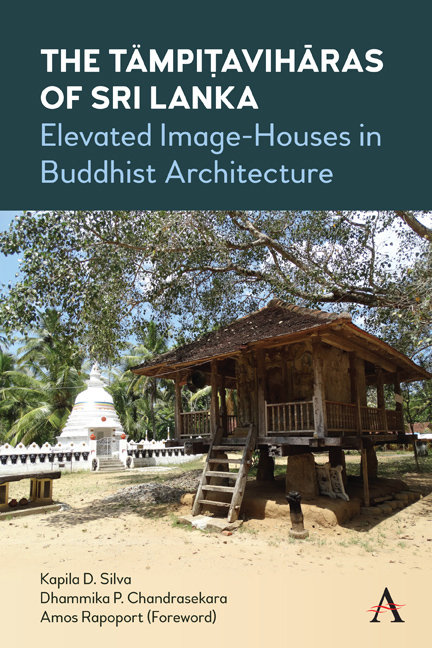Conclusion
Published online by Cambridge University Press: 16 December 2021
Summary
Influenced by thirteenth century relic temples, tämpiṭavihāras eventually developed into simple, distinctive forms of image-houses, commanding the highest ritualistic significance among the monuments of late eighteenth and nineteenth century Kandyan monasteries. With complex architectural and iconographical combinations, they exhibited an unprecedented semiology of Buddhist cosmology and worldview. In addition to being a trove of art and architecture of the Kandyan period, ṭämpiṭavihāra tradition provides the much-needed evidence to explore the missing links, continued practices, and transformations of art and architecture in the spell between the post-Polonnaruva era and the Kandyan period.
Our goal in this study was to emphasize that climatic responsiveness or technological limitations were neither the sole nor the primary reason for the emergence of ṭämpiṭavihāras. Other major factors – ritualistic, sociopolitical, cultural, and architectural – were at work. We argue that architectural symbolism has been a vital determinant in the evolution as well as in the form and character of this image-house type. We present several hypotheses: The raised floor construction along with the iconography gave a ‘floating’ effect to the image-house symbolizing a cosmic realm; ṭämpiṭavihāra embodied a complex and composite form of early architectural conceptions of the imagehouse, representing the Enlightenment of the Master as well as his monastic cell. The practice of using image-houses as relic houses and upōsathāghara at a certain time of its evolution led to the emergence of ṭämpiṭavihāras. These postulations are based on our observations and the limited architectural and literary evidence available. Thus, they need further research. We also have not examined the influence of certain ancient śilpa-śastra treatises, such as Mānasāra, Mayamata, Śāriputra, or Vaijayantatantra, on ṭämpiṭavihāra architecture, murals, imagery, symbolism, and construction rites. This is another study to be carried out.
Thorough research on the two-storied ṭämpiṭavihāras of the post-Polonnaruva era should be conducted. Although these paṭimāgharas are no longer extant, archaeological investigations, literary sources, and folklore might provide some information. Certain building components of these image-houses were reused in constructing the existing ṭämpiṭavihāras. This remaining evidence could be identified and used in research. We have argued that the ṭämpiṭavihāras fulfilled the need for a stūpa in a monastery. The examples for this tradition should be identified, as it would validate this postulation and be useful in understanding the evolution of ṭämpiṭavihāra.
- Type
- Chapter
- Information
- The Tämpitaviharas of Sri LankaElevated Image-Houses in Buddhist Architecture, pp. 67 - 70Publisher: Anthem PressPrint publication year: 2021

